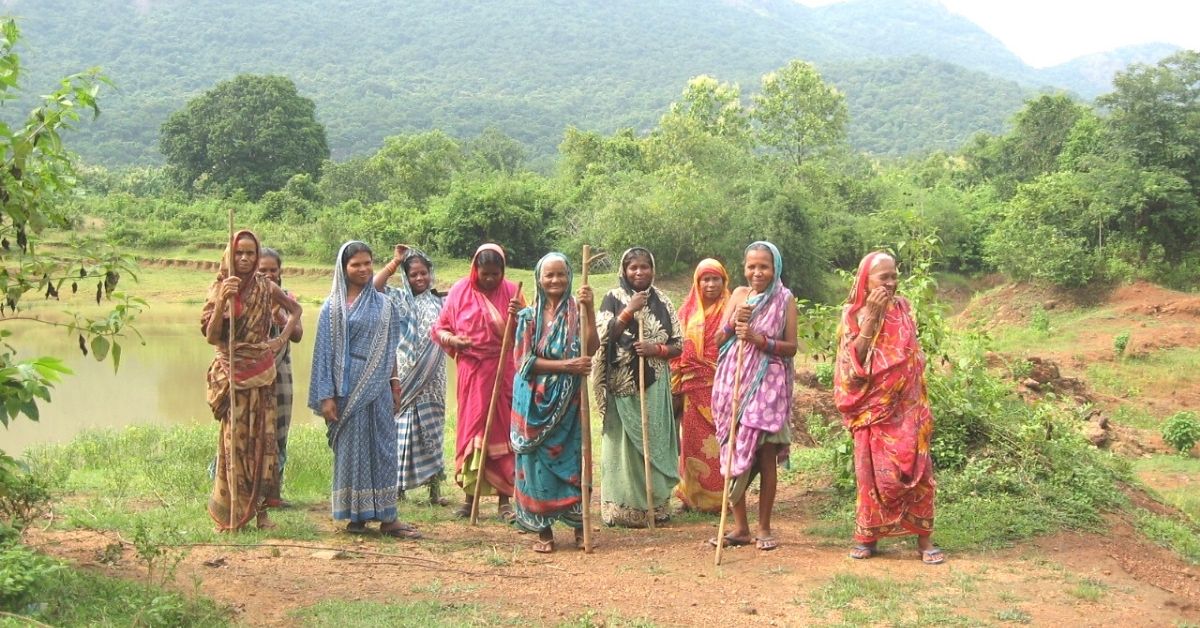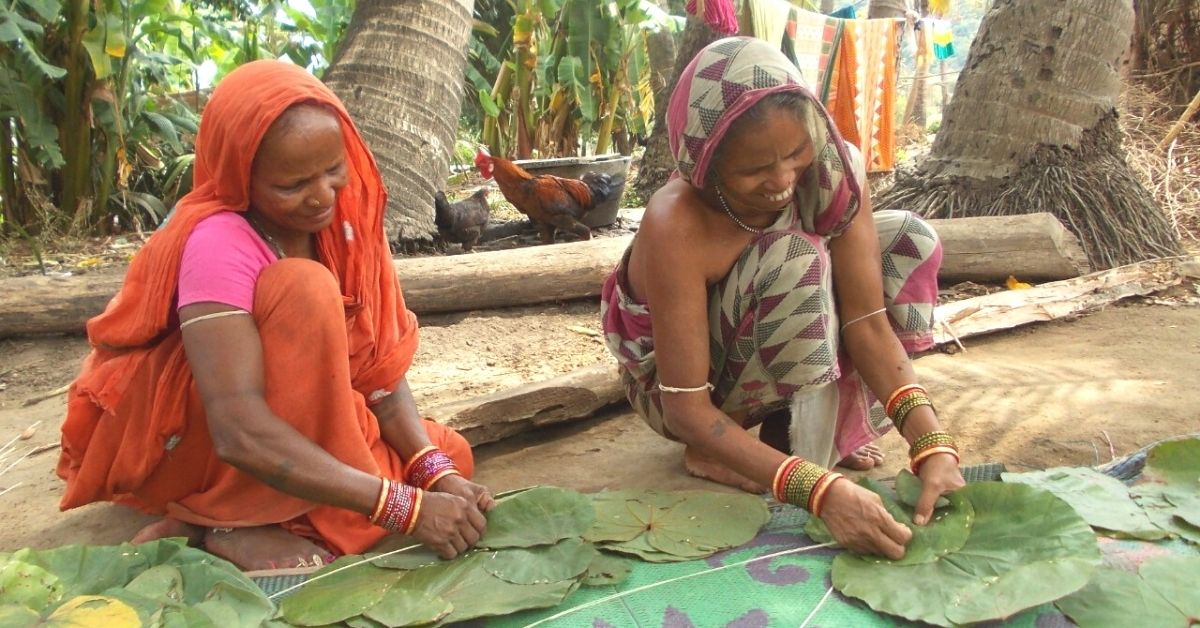How Tribal Women Have Been Protecting 1/3 of Odisha’s Forests, All By Themselves
Women in 135 tribal villages of Odisha observe 'thengapalli' to safeguard forest resources from over-exploitation

Every morning most women in the Kodarapalli tribal village in Odisha prepare to fetch forest resources and then prepare for their household chores. Interesting, a few others pick up lathis or sticks instead – and head to the forest.
These women do not venture to hunt an animal for meat or protect themselves from anti-social humans or wild animals. Instead, these women set out to safeguard the forest and its resources.
The activity is called ‘thengapalli’, which translates to ‘thenga’, meaning sticks and ‘palli’, explained as ‘turn’. It is a practice where members from the village participate in protecting their community forest. It involves around 4-6 women patrolling the forest’s boundaries in shifts. Once their turn ends, another bunch of women change the guard. The patrolling is done in three shifts starting at 6 am and lasting until the late hours.
Interestingly, the practice is not new and has been carried out for at least five decades, long before the Forest Rights Act, 2006 came into place. Over the years, hundreds of acres of forest have come under protection in 135 villagers guarded by men and women. Out of the total, 62 villages see women taking complete charge of the forest protection. Their conservation efforts have helped rejuvenate over 500 acres of forest land under their protection.
Women become guardians of nature

“We protect the forest from smugglers, timber thieves and people who rob the natural resources without permission. The forest gives us wood, tubers, roots, tobacco leaves, mohua flowers, medicines and all-natural resources needed in all aspects of our livelihood. If we let it go, there will be nothing left for us,” says Promila Pradhan, a president of the protection committee from the village.
“Earlier, a significant patch of the forest was left barren due to overexploitation of resources. Illegal tree-cutting and looting of resources were rampant. The villagers realised that soon there would be none left, and hence we started protecting it,” she told The Better India.
Promila explains the practice started in the 1970s from Nayagarh district and slowly spread across the villages in other parts of the state. “The story in the community revolving about women’s involvement is that the men guarded the forest earlier. However, once a bullock cart was loaded with timber and was confiscated by the villagers. The women from the village seized the goods and brought the wrongdoers to justice by taking the thieves to the police station. Since then, women actively participated in the protection, and the incidents of timber theft reduced,” she adds.
“Men tend to end up in conflict with the smugglers and sometimes even have a lenient approach. On the contrary, the women understand the importance of resources and their values deeply. They do not let go of the criminals until they are brought to justice. Hence, women started taking charge of guarding the forests,” she says.
The villager says that the years of effort has brought a check to the overexploitation of forests and made them sustainable, allowing all of them to coexist with nature.
Y Giri Rao, executive director at an NGO, Vasundhara, has been documenting the tribals for years and says the villagers lost their ownership of the natural resources after the British labelled the area as a reserve forest. “It led to protests as the villagers became deprived of trees and fish, their only means of livelihood. The then king Shankar Pratap Singh Dev Mahendra of Dhenakanal issued orders thereby restoring rights for the community,” he says.
Giri says that as the threats of looting the forest resources began to rise, the villagers started facing the brunt.

“The villagers who accessed resources within the 1-2 km radius found themselves venturing out for 10 km or more. Some villages faced wood shortages to the extent that they did not have wood for the pyre to perform the last rites of their loved ones,” he shares.
The villagers realised the gravity of depleting resources, and slowly the villages started patrolling the borders of the jungles and formed clusters of villagers to protect the resources around them. “They identified the routes of timber mafia and smugglers and busted their activities through the village network,” he says.
Giri adds that apart from patrolling, other cultural and social aspects blended in over the years that helped to build a robust conservation system.
A self-evolved conservation model
The tribals started building socio-economic relationships with other villages. “There were marriages within villages to form social bonds, and trade took place among other activities that closely knit the bond between them. The move came with an added advantage as it reduced conflicts among villagers over sharing resources,” he says.
The social bonding laid robust foundations defining rules and regulations collectively drawn by the community members. “The villagers decided which plants or trees to source as per the need or season. They could modify rules as they understood the biodiversity and its dynamics by living closely,” he says.
Regarding other conservation aspects, Giri adds that during summer months, the community adheres to strict rules of not carrying matchbox or beedis for smoking as they could cause forest fires. “Every household has a water bucket outside their homes, in case of fires. There are water ponds in the forest areas for the same. The violators face a fine of Rs 50 to Rs 100 if they fail to abide by the rules,” he says.
Even during the collection of resources, not more than two members of a family are allowed. “It puts restrictions and limitations enabling mindful use of natural resources. Some tribals go out for labour work in cities. In such cases, the rotation concept helps to ensure that all community members are involved. It is important to remember that none of the rules was imposed by the forest officials and evolved within the community with time,” he explains.
Giri says that according to the forest department estimates from 2005, about 1.17 million hectares of forest land is protected and maintained by 1.5 million families.

“It amounts to one-third of the forest area. Thengapalli is practised in 135 villages where men and women guard the forest out of which in 62, women bear the torch of safeguarding their resources,” he adds.
“It is observed that men are often rigid and selective about protecting the biodiversity of the forest. On the other hand, women show flexibility and a deeper understanding of the forests that reflects in their tendency to protect wider species,” Giri says.
Illustrating a recent example, Giri adds that during the COVID-19 lockdown, the women identified 117 varieties of forest foods they could access – ranging from mushrooms, leafy vegetables and fruits.
Swasthi Pradhan, a villager, says there is no intervention from the forest department, and the community holds the protection rights of the forest. “The community members have become self-sufficient from 1998 and ensure the forest regrows and flourishes. If there are no trees, tubers or food, our lives will remain threatened. Everyone understands that. Hence, conservation and protection of forest are at the core of every tribal,” she adds.
Over the past 20 years, Giri has been monitoring and documenting the wisdom of the community that evolved over decades. “There is no written rule book about the practices formed, and hence it is important to pass them on to future generations,” he says.
Giri says that the conservation methods are proof that a blanket government policy cannot apply across the communities in India. “These communities have led and paved the path of conservation. Their contribution in protecting biodiversity cannot go ignored,” he adds.
Edited by Vinayak Hegde
If you found our stories insightful, informative, or even just enjoyable, we invite you to consider making a voluntary payment to support the work we do at The Better India. Your contribution helps us continue producing quality content that educates, inspires, and drives positive change.
Choose one of the payment options below for your contribution-
By paying for the stories you value, you directly contribute to sustaining our efforts focused on making a difference in the world. Together, let’s ensure that impactful stories continue to be told and shared, enriching lives and communities alike.
Thank you for your support. Here are some frequently asked questions you might find helpful to know why you are contributing?


This story made me
-
97
-
121
-
89
-
167











